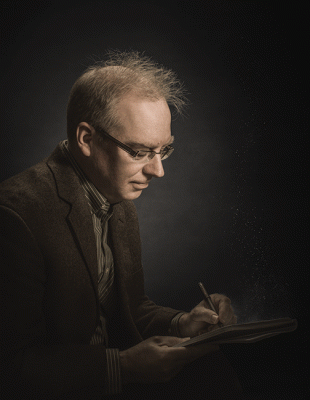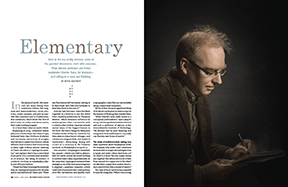
Even in the era of Big Science, some of the greatest discoveries start with someone—Penn physics professor and Nobel contender Charles Kane, for instance—just sitting in a room and thinking.
BY KEVIN HARTNETT | Photograph by Chris Crisman C’03

In the physical world, few materials are more boring than insulators. Others, like magnets and semiconductors, move electrons, create currents, and give us marvels like computers and LCD televisions. But insulators, which block the flow of electricity? As Auden said about poetry, they make nothing happen.
Or at least that’s what we used to think.
Beginning in 2004, condensed matter physicist Charles Kane, the Walter H. and Leonore C. Annenberg Professor in the Natural Sciences, had a series of insights that led him to realize that there is a whole different kind of matter that’s been sitting in plain sight without anyone realizing it’s there. He calls it a “topological insulator,” and explains that it has a weird kind of property: it is a conventional insulator in its interior, but along its surface, it conducts electrons in remarkably orderly and efficient fashion.
“People had been [studying] the materials that are topological insulators for decades and no one had noticed,” Kane says. “There was this treasure left uncovered, waiting to be discovered, and I feel very fortunate to have been there to discover it.”
Over the last few years, Kane has been regarded as a favorite to win the Nobel Prize, based on predictions by Thomson Reuters, which measures influence by analyzing how often a scientist’s work is cited in other studies. Kane has already earned many of the biggest honors in the field—the latest being the Benjamin Franklin Medal in Physics, which he, his Penn physics department colleague and collaborator Eugene Mele, and Stanford University’s Shoucheng Zhang will receive at a ceremony at the Franklin Institute in Philadelphia on April 23.
The discovery of topological insulators has opened a whole new field in physics, with lab teams around the world working to confirm Kane’s ideas experimentally. At the same time, topological insulators have emerged as one of the most promising ways to engineer a quantum computer—a Holy Grail kind of invention that could produce error-free calculations and quickly crack cryptographic codes that are untouchable using conventional computers.
Yet for all that, the most significant thing of all about topological insulators may be the manner of thinking that revealed them.
“What Charlie’s work really shows is a conceptual profoundness,” says Liang Fu Gr’09, a former graduate student of Kane’s and now a professor of physics at the Massachusetts Institute of Technology. “He showed that by pure thinking and using ideas from mathematics, you really can theorize new forms of matter.”
The study of matter involves asking very basic questions about the physical world. For example, why under some conditions do molecules of oxygen and hydrogen form a liquid, and under others they form ice? Or, what is it about the way copper atoms join together that allows electricity to flow from one end of a copper wire to the other? Or, why does a copper wire conduct electricity so much better than a strand of plastic?
This type of basic question has appealed to Kane for a long time. “When I was a young child the thing I really loved was mass,” he says. “I would spend my free time thinking about it.”
The difference between materials that insulate and conduct is one of the basic distinctions in condensed-matter physics. In an experimental sense, the difference is easy to see: stick a knife in a toaster and you’ll get a shock; use a wooden chopstick instead, and you’ll be okay.
In the early 20th century, physicists developed a powerful theoretical framework called the band theory of solids that explains those differences. In simple terms, band theory says that when a large number of atoms combine to form a crystalline material, their electrons collect in layered bands of energy. The difference between a conductor and an insulator has to do with how those bands are spaced: In a conductor, there’s no gap between the conducting band and the valence band, thus enabling the free flow of electrons; in an insulator, there’s a large gap between the two bands, which traps electrons where they are.
This phenomenon came to mind for Kane in 2004, when he heard a rumor that a pair of physicists at the University of Manchester in England had figured out how to isolate a material called graphene, whose properties had tantalized physicists for nearly a century. Graphene is a nearly transparent sheet of pure carbon atoms, one-atom thick. This remarkable thinness means that in some real sense, it’s a two-dimensional object, which limits the motion of electrons and makes it an interesting material in which to think about how electrons behave.
“When [Gene Mele] and I realized two-dimensional planes of graphene were something people were going to do experiments on, we realized we had to think of something interesting to say about this,” Kane says. “I was trying to think to myself, what is it that’s interesting [about graphene], is there anything I can say that’s new?”
Kane is a theoretical physicist, which means that when he looks for new discoveries, he doesn’t work in a lab or run experiments. Instead, he thinks. (Kane says he realized he wasn’t cut out to be an experimentalist as an undergraduate at the University of Chicago: “I spent senior year working in an experimental lab and one of the things I learned is … I wasn’t good at soldering.”)
When Kane thinks, his tools are mathematics, logic, and the laws of physics. He starts with data collected from experiments, or from a description of the properties of a material like graphene, and he tries to answer questions like: What kind of theoretical models explain the phenomena people are observing in labs? Or, given that a material is known to have certain properties, what else should be true about it?
In the case of graphene, Kane was particularly intrigued by the fact that it occupies a middle ground between insulators and conductors. The electron bands in graphene have a gap between them, which should make it an insulator, but the gap between those bands is vanishingly small. This means that a sheet of graphene is an insulator in its interior, but conducts electricity along its edge.
Over the course of 2004, Kane turned graphene’s strange conducting edge states over and over in his head. He had frequent conversations with Mele, who, he says, “taught me everything I know about graphene,” and he created a computer program that modeled graphene’s properties. In trial-and-error fashion, he added new terms to the model, often without knowing what they’d do, trying to determine if there was a way to make graphene’s conducting edge states go away (because if he could make them go away, he’d know what was sustaining them in the first place). Yet no matter how he reconfigured the model, the edge states persisted.
“I was faced with this question, which is ‘Why aren’t the edge states going away?’” Kane says.
To answer that question, he used techniques from topology, a discipline in mathematics concerned with classifying spaces in different dimensions. All theoretical physicists are skilled at math, but Kane has a unique ability to translate between the deeply abstract world of theoretical physics and laboratory work. “Charlie is precisely someone who is in the middle,” Fu says. “He has the intellectual power to understand or learn advanced mathematics, and on the other hand he’s always grounded, always likes to think whether this phenomenon can be realized in a lab.”
When it came to explaining why graphene conducted electricity along its edge, Kane followed topological thinking to two key insights. The first occurred when he realized that a feature of quantum mechanics called “time-reversal symmetry” was protecting the edge states, essentially assuring that they had to exist. Recognizing that, Kane says, “was a major sort of a-ha moment.”
“The thing that is special about this different insulator is the fact that it’s guaranteed to conduct on its surface and guaranteed not to conduct on its interior,” he adds. “There’s some sense in which the conducting surface is protected by quantum mechanics.”
The second insight came to him one evening as he was getting ready to go to sleep. Kane knew the edge states were a one-dimensional conductor (if a sheet of graphene is two-dimensional, the edge of that sheet is one-dimensional: a single line of carbon atoms). He also knew that prevailing theory said one-dimensional conductors were supposed to be susceptible to a phenomenon known as Anderson localization. But Kane realized that time-reversal symmetry protected the conducting edge states of graphene from Anderson localization. Thus, even if he introduced impurities—or made it “dirty”—the conducting properties would persist, leading to a behavior he called the quantum spin Hall effect.
“Lying in bed one night, I came up with a simple argument that convinced me if you made it dirty you couldn’t make it into an insulator,” he says. “That convinced me this was something that was really new.”
In 2005 Kane and Mele published an article in the Physical Review of Letters describing a new kind of insulator, which they called a quantum spin Hall insulator (the term topological insulator was introduced by a different pair of physicists in a paper the next year). Mele says it took him a while to realize the significance of what they’d done. “I think we knew [our work] was good and interesting,” he says. “It took me a couple years to appreciate how deep it was.”
The really remarkable feature of topological insulators is the way they control the flow of electrons, essentially taking these fickle, disorderly particles and forcing them to flow in an orderly way.
“In an ordinary conductor electrons are always bouncing back and forth, but in these [conducting edge states] the electrons are always going straight,” Kane says. “There’s a sense in which the conduction in these edge states is more organized.”
He adds that topological insulators also serve as evidence that topological thinking has an important role to play in condensed matter physics. “One of the things I feel proudest about with topological insulators is that it brought out topology as an organizing principle for thinking about matter,” he says. “The ideas of topology allow you to sort of classify what kinds of states are possible.”
The paper described the properties of topological insulators, but it didn’t explain how to actually make one. Kane and Mele initially thought that graphene would be a topological insulator, but for reasons having to do with the low weight of carbon atoms (compared to “heavier” elements further down the periodic table), it’s not. Instead, graphene established the principle that topological insulators should exist in the world. In order to actually make one, though, another kind of material would have to be found.
“The challenge was how do we make it happen in the real world, because this topological insulator idea is a beautiful idea, but it doesn’t come to life until it happens in the real world,” Kane says. “Thankfully there are such materials. Unfortunately, I didn’t discover them, my competitor did.”
Kane’s competitor—one of two men with whom he’s shared many of the top honors in physics over the last few years—is a theoretical physicist named Shoucheng Zhang at Stanford. In 2006, a year after Kane and Mele’s paper predicting that topological insulators should exist, Zhang published a paper in Science predicting that it should be possible to fabricate a topological insulator out of a material called mercury telluride. A year later, in 2007, an experimental physicist who works in Germany named Laurens Molenkamp followed Kane and Zhang’s leads and became the first person to actually make a topological insulator in a laboratory, closing the loop on an idea that had begun three years earlier when Kane had started to ponder graphene.
While it’s not uncommon for scientific discoveries to build on each other in this way, in one respect the path to creating a topological insulator was fairly unique. Usually in physics, experimental data comes first: scientists working in labs observe some kind of surprising phenomenon, and over time theoretical physicists build mathematical models that explain those initial observations. The classic example is superconductors, which were discovered by accident in 1911 in the Netherlands, but were not understood theoretically until the 1950s.
With topological insulators, the opposite happened. They began as an idea, a prediction based on topological ideas that a certain kind of matter should exist, which was later confirmed through experiments.
“The major epochs of civilization are all named after materials—the silicon, steel, iron ages—and all of these materials were discovered serendipitously,” says Zhang. “This time is different, because we predicted [topological insulators] theoretically first and then, based on the predictions, we went to look for it, and we found it.”
Topological insulators are a beautiful idea. They also have a number of significant practical uses, some of which were apparent right away, and some of which only emerged several years after Kane and Mele first proposed their existence.
The most obvious use of topological insulators—which has not actually been implemented yet—is as a better kind of conductor in electronics. In conventional conductors, electrons flow in unruly fashion: whenever they strike an impurity, they bounce and backscatter, giving off heat, which limits how electronics perform. But along the conducting edge states of topological insulators, the laws of quantum mechanics forbid them from bouncing around, which limits heat dissipation and could lead to higher performance machines.
That’s one use. There is, though, a “higher, more ambitious thing that one might be able to do with these topological surface states,” says Kane—and that’s to build a quantum computer, which would perform calculations by manipulating electrons, and would be thousands of times more powerful than any computers we have today.
The field of quantum computing originated in the early 1980s based in part on work by the famed physicist Richard Feynman. The main difference between quantum computing and regular computing has to do with the way information is stored and manipulated. A regular computer uses binary code, or bits, in which data is recorded as either a one or a zero. A quantum computer uses qubits, which are much more versatile way of storing data. Qubits arise in quantum systems that can exist in two distinct states. For instance, an extra electron can either be present in a given location (equivalent to the “1” in a bit) or not present (equivalent to the “0” in a bit). Moreover, due to the weird behavior of particles at the quantum level, it can be in a superposition of those states, both occupying and not occupying the position at the same time.
“In a quantum computer, the way information is stored, you have zeroes, ones, and also combinations of zero and one,” says Kane. “That makes a quantum computer something that’s more different and powerful.”
There are many obstacles to making a quantum computer, but a single fundamental one: Qubits, like the electrons that form them, are notoriously fragile and need to be stored in complete isolation from their environment. If they’re not, they react with their surroundings, which causes them to “decohere,” destroying their quantum nature and the information they encode.
There are a number of proposals for how to create qubits that maintain their integrity long enough to perform calculations. One idea that ended up having particular relevance to topological insulators was proposed in 2000 by a physicist named Alexai Kitaev at the California Institute of Technology. Kitaev realized that a strange particle known as a Majorana fermion—named after the Italian physicist Ettore Majorana, who first proposed their existence in 1937—might be able to store quantum information in a way that intrinsically resisted decoherence.
For what Kane describes as a “deep and fundamental reason,” Majoranas have to come in pairs, which are still connected even when the parts of the pairs are separated. Kitaev explained that each particle in a Majorana pair could store half of a qubit of information, and because the particles could be stored separately from each other, they were not susceptible to decoherence. Kitaev proposed Majorana fermions as the basis for a “a topological quantum computer”—the only hitch was that at the time, Majorana fermions had only been described theoretically, and had never actually been observed in the world.
That was one insight that would end up being relevant to Kane’s work. Another took place three years after Kitaev proposed his idea for a topological quantum computer. In 2000, Dmitry Green and Nicholas Read, a pair of physicists at Yale University, published a paper describing the conditions under which Majoranas might be found. They showed that under special conditions of superconductivity—what’s known as a “superconducting vortex”—the elusive Majorana might emerge.
That was still the state of things in 2007, when Kane started working with “a brilliant PhD student” named Liang Fu. Together, Kane and Fu started to talk about what would happen if they turned the conducting edge states of a topological insulator into a superconductor, which Kane describes as “sort of a natural question to ask.”
Kane and Fu realized it was very easy to accomplish that—all they had to do was place a known superconductor alongside a topological insulator, and the superconductivity transferred over. The next insight, though, was more remarkable, and pointed toward the creation of a topological quantum computer.
“One day [Charlie] asked if I thought there’d be Majorana fermions [along a superconducting topological insulator],” Fu says. “I went home, did half an hour of calculating, solved an equation, and the next day I presented it to Charlie. He got quite excited.”
Fu’s calculations showed that the conducting edge states of topological insulators, under conditions of superconductivity, were indeed capable of “hosting” these long-anticipated Majorana modes.
“With these Majorana fermions,” says Fu, “each particle is in some sense a fractional object—you’re encoding one qubit in a pair of Majorana fermions. If they are far apart then this quantum bit is defined non-locally and the environment will not degrade [it].”
Kane describes the creation of a quantum computer as a “very difficult problem, but one which could be solved in this century.” Teams of researchers are exploring different strategies for engineering quantum computers, a number of which focus on using topological insulators as the phase of matter in which to realize these Majoranas. It’s a search that was spawned by an idea, which is representative of how Kane’s career has unfolded.
“Everything for me has been like that,” Kane says. “Even the predicting real materials for me, it was based on realizing that if I thought about it in the right way, I could make [it].”
At the end of October, physicists gathered at Princeton for a conference called “Majorana Zero Modes and Beyond.” They came from around the world—Germany, France, the Netherlands, Israel, as well as Texas, Boston, and West Philadelphia—to discuss the latest efforts to observe Majorana fermions in a laboratory setting. Over the last few months several groups had reported some success, including a team from Princeton that had glimpsed a Majorana at the end of an atomic wire, and a group from Harvard that is getting closer to being able to produce Majoranas on the conducting edge states of topological insulators.
Liang Fu and Charles Kane were there, too. After he returned, I asked Kane what it had felt like to be at the conference, knowing that his ideas were behind so much of the research that had been discussed.
“Certainly I do feel a certain awe in the fact that this was something I was in at the beginning of and it’s developed in ways that I did not foresee,” Kane replied. “It’s awe-inspiring to have been a part of that.”
This April, Kane, Mele, and Shoucheng Zhang will receive the Franklin Medal for their work on topological insulators over the last decade. It’s one of the last big honors Kane has not yet received. Afterward, maybe the Nobel Prize awaits.
Kane regards topological insulators as one of the last pieces in the effort to catalog states of matter using the band theory of solids. He calls band theory one of the great triumphs of 20th-century physics, but also notes that it has its limits.
Band theory is very good at describing situations where electrons organize themselves neatly. There are other, more exotic states of matter out there that aren’t so easy to describe, in which, Mele says, “the interactions among the electrons are so strong you don’t really have that band property.” He adds that at this point, “we know almost nothing” about how to model the behavior of electrons in those kinds of systems.
Many of the same characteristics that helped Kane discover topological insulators will be important in the effort to pin these seemingly freewheeling states of matter down into a series of equations—the willingness to ask simple questions, and the ability to use complex ideas from mathematics to answer them. Kane is among a small group of physicists taking the lead in this effort. Fu thinks one of Kane’s greatest contributions to physics might end up not being any one particular discovery, but rather a style of inquiry, a way of sizing up ideas and phenomena that at first make no sense.
“Charlie always wants to think from the most elementary [level] and build on top of it,” Fu says. “To follow his spirit you think about how abstract mathematics can translate into measured effects in labs. Many people are following this spirit.”
Kevin Hartnett writes the Brainiac column for The Boston Globe’s Ideas section and lives in South Carolina.





Mr. Hartnett,
I read with great interest your article on recent advances in, or at least renewed focus on, topological insulators. The method by which this was arrived at by Dr. Charles Kane is even more fascinating (in a thinly veiled homage to the late Leonard Nimoy). This could be one more link in the sequence of thought experiments that brought us Einstein’s General Theory and Schrödinger’s Cat.
Especially moving was Einstein’s ability to “sit in a room and think”, what if common metrics are not universally constant across observers in motion? What if, of all things, the speed of light is the universal constant, and our common notions of measure and time must dilate or shrink in accordance to Lorentz’ transformations? That thought experiment is not only powerful in its own right, it produced one of the most successful theories in the history of science. Hopefully, Dr. Kane’s thought experience will be equally fruitful.
Sincerely
Jack Beyda EAS ’84